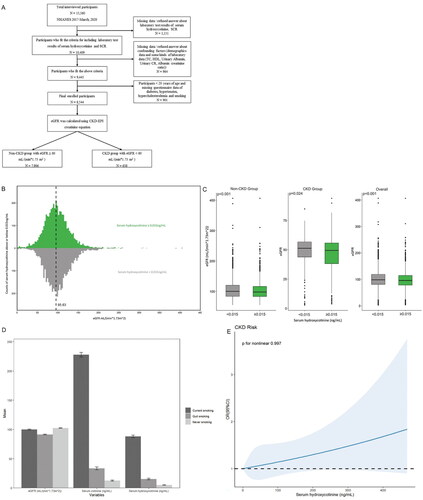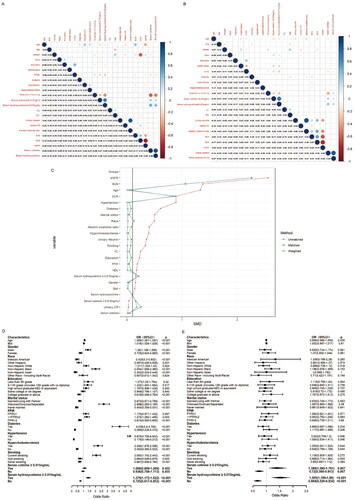Figures & data
Figure 1. (A) Study population.Distribution (B) and distinction (C) of eGFR with serum hydroxycotinine categorized by LLOD at 0.015 ng/mL in baseline data. (D) Effects of different smoking status on eGFR, serum cotinine and serum hydroxycotinine using baseline data. (E) Restricted cubic spline models for the relationship between serum hydroxycotinine and the CKD using baseline data. The 95% CI of the adjusted OR was represented by the gray-shaded area. The model was adjusted for age, BMI, gender, race (Mexican American, other Hispanic, non-Hispanic white, non-Hispanic black, Non-Hispanic Asian, and other race), education (Less than 9th grade, 9-11th grade (Includes 12th grade with no diploma), High school graduate/GED or equivalent, Some college or AA degree, College graduate or above), marital status (married/living with partner, widow/divorced/separated, and never married), FPIR, hypertension, hypercholesterolemia, diabetes, smoking (current smoking, quit smoking, never smoking), TC, HDL, Urinary Albumin, Urinary CR, Albumin creatinine ratio. (CI, confidence interval; OR, odds ratio.).

Table 1. Baseline characteristics for the non-CKD group and CKD group, as well as stratified by LLOD of serum hydroxycotinine at 0.015 ng/mL.
Figure 2. Correlation between serum hydroxycotinine ≥0.015 ng/mL and the baseline data in non-CKD group (A) and CKD group (B). The color represents the association’s strength. The Pearson’s correlation coefficient was used to calculate the correlation. (C) Distribution of SMD for the unmatched, matched and weighted non-CKD and CKD subjects with a ratio of 1:1. (SMD, Standardized mean difference). Forest plot of CKD risk factors before (D) and after (E) matching.

Table 2. Characteristics of full and popensity score-matched cohorts by CKD.
Data availability statement
The datasets presented in this study can be found in online repositories. The names of the repository/repositories and accession number(s) can be found below: www.cdc.gov/nchs/nhanes/
